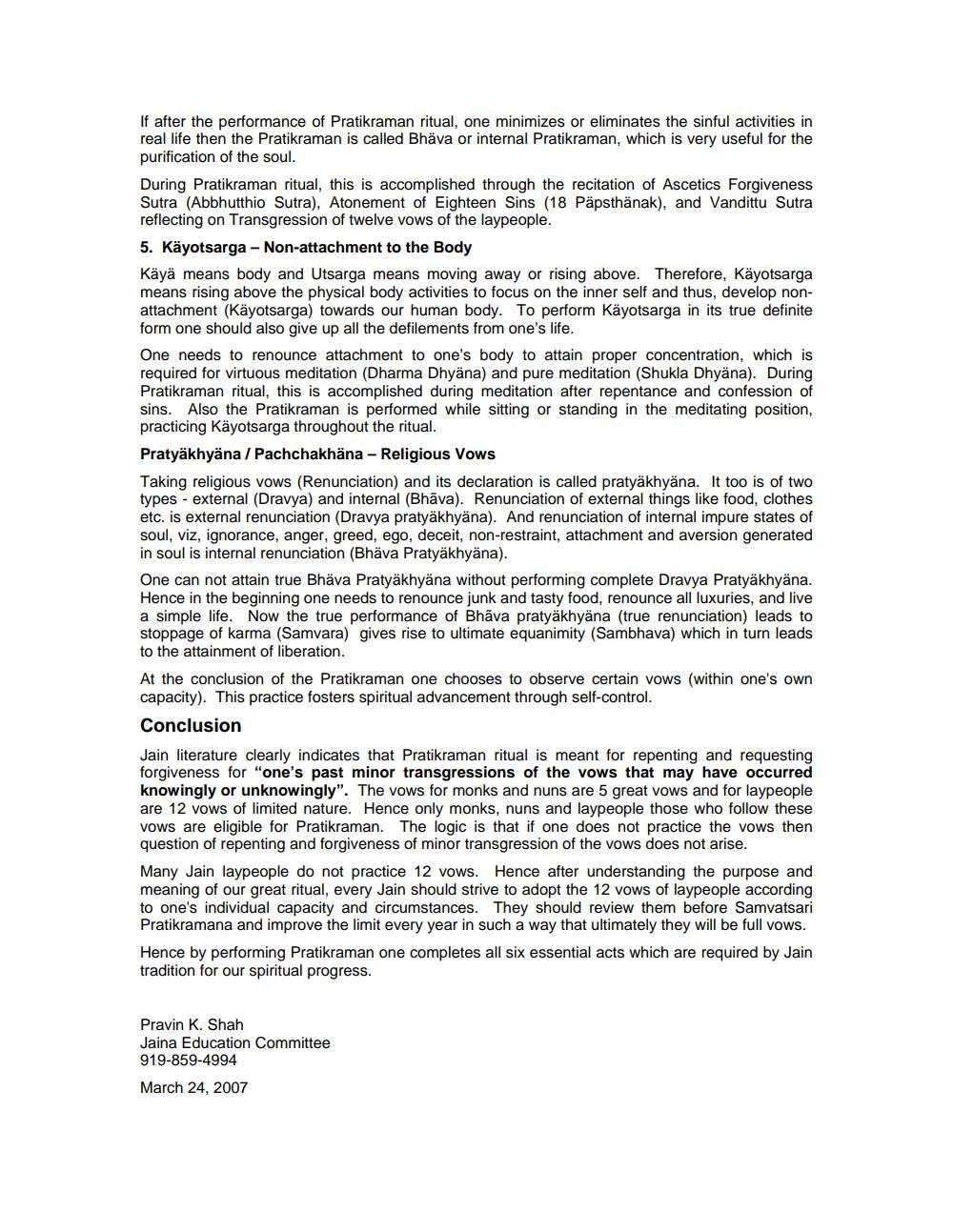________________
If after the performance of Pratikraman ritual, one minimizes or eliminates the sinful activities in real life then the Pratikraman is called Bhäva or internal Pratikraman, which is very useful for the purification of the soul. During Pratikraman ritual, this is accomplished through the recitation of Ascetics Forgiveness Sutra (Abbhutthio Sutra), Atonement of Eighteen Sins (18 Päpsthänak), and Vandittu Sutra reflecting on Transgression of twelve vows of the laypeople. 5. Käyotsarga-Non-attachment to the Body Käyä means body and Utsarga means moving away or rising above. Therefore, Käyotsarga means rising above the physical body activities to focus on the inner self and thus, develop nonattachment (Käyotsarga) towards our human body. To perform Käyotsarga in its true definite form one should also give up all the defilements from one's life. One needs to renounce attachment to one's body to attain proper concentration, which is required for virtuous meditation (Dharma Dhyana) and pure meditation (Shukla Dhyana). During Pratikraman ritual, this is accomplished during meditation after repentance and confession of sins. Also the Pratikraman is performed while sitting or standing in the meditating position, practicing Käyotsarga throughout the ritual. Pratyakhyana / Pachchakhana - Religious Vows Taking religious vows (Renunciation) and its declaration is called pratyakhyana. It too is of two types - external (Dravya) and internal (Bhava). Renunciation of external things like food, clothes etc. is external renunciation (Dravya pratyakhyana). And renunciation of internal impure states of soul, viz, ignorance, anger, greed, ego, deceit, non-restraint, attachment and aversion generated in soul is internal renunciation (Bhäva Pratyakhyana). One can not attain true Bhäva Pratyakhyana without performing complete Dravya Pratyakhyana. Hence in the beginning one needs to renounce junk and tasty food, renounce all luxuries, and live a simple life. Now the true performance of Bhava pratyakhyana (true renunciation) leads to stoppage of karma (Samvara) gives rise to ultimate equanimity (Sambhava) which in turn leads to the attainment of liberation. At the conclusion of the Pratikraman one chooses to observe certain vows (within one's own capacity). This practice fosters spiritual advancement through self-control. Conclusion Jain literature clearly indicates that Pratikraman ritual is meant for repenting and requesting forgiveness for "one's past minor transgressions of the vows that may have occurred knowingly or unknowingly". The vows for monks and nuns are 5 great vows and for laypeople are 12 vows of limited nature. Hence only monks, nuns and laypeople those who follow these Vows are eligible for Pratikraman. The logic is that if one does not practice the vows then question of repenting and forgiveness of minor transgression of the vows does not arise. Many Jain laypeople do not practice 12 vows. Hence after understanding the purpose and meaning of our great ritual, every Jain should strive to adopt the 12 vows of laypeople according to one's individual capacity and circumstances. They should review them before Samvatsari Pratikramana and improve the limit every year in such a way that ultimately they will be full vows. Hence by performing Pratikraman one completes all six essential acts which are required by Jain tradition for our spiritual progress.
Pravin K. Shah Jaina Education Committee 919-859-4994 March 24, 2007




